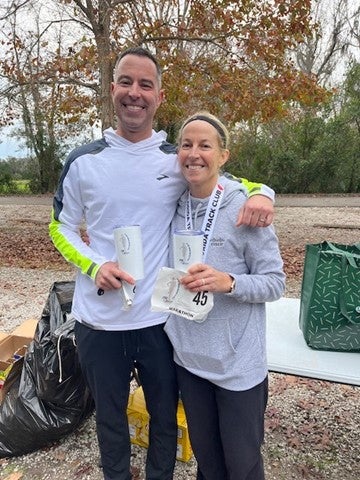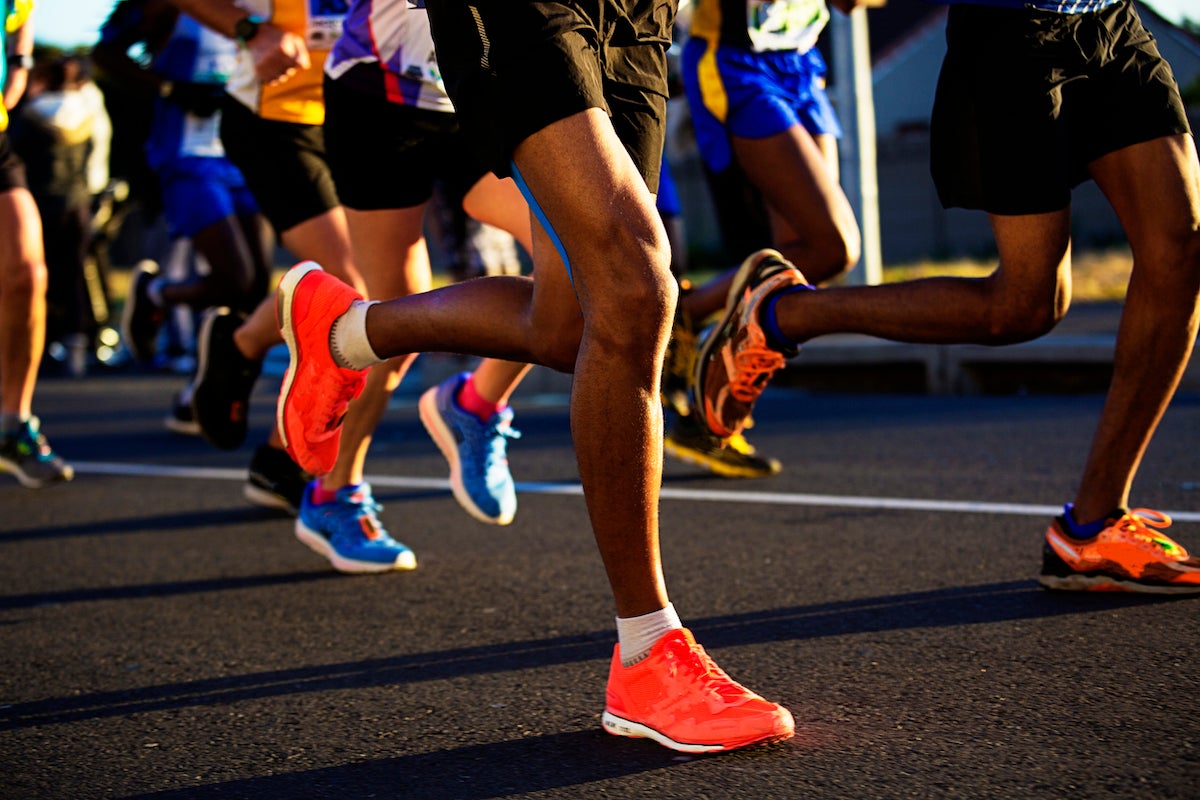The Boston Marathon brings together thousands of runners who earn an entry to the coveted event by meeting rigid qualifying times in runs held across the nation. This year’s event takes place on April 15.
A panel of faculty experts from the College of Health Professions and Sciences, many of them accomplished long-distance runners themselves, share what it takes to prepare for 26.2 miles and discuss some of the new trends and technologies competitors are using to prepare and compete.

What kind of running regimen should be followed to prepare for a marathon? Training for this distance has unique demands in terms of how to fuel and hydrate the body as well as developing a successful training regimen, says Peter Buffington ’12DPT, UCF Physical Therapy Clinic director. He has run 17 marathons, including six Boston Marathons, and has already qualified for the 2025 Boston Marathon.
For most prospective marathoners, training will take four to six months, Buffington says.
“A runner must figure out how to increase running velocity (through speed work) and to maintain that pace even when their legs have a significant amount of fatigue,” he says. “For many runners coming to the marathon from a shorter distance, this means extending their long run to 2.5 to 3 hours.”
Buffington says one training technique is “slow running,” which places an emphasis on running slower on easy days, coupled with adequate recovery, to ultimately improve speed.
“Some experts use the analogy of a sponge: people are better able to ‘absorb’ the training when running at a slower pace on the day or two after a fast session,” he says. “Those easy miles serve a purpose: they allow for less stress on the lower legs which, in turn, allows a runner to withstand an overall higher volume of training.”
Aside from running, what other physical preparation is needed?
Get your body checked out before you start training, sports medicine experts say. An examination from a physical therapist can assess joint range of motion, muscular strength and muscular flexibility to identify any asymmetries or weaknesses and help prevent injuries. Carey Rothschild, a clinical associate professor in the Division of Physical Therapy, says core and hip stability are key components of running, and strengthening them is essential to support the demands of marathon training.

“Runners want to run, not strength train,” Rothschild says. “But for longevity in sport, the body’s tissues must be robust and resilient to withstand the demands of marathon training. Ultimately, the runner should complete functional strength training a minimum of two to three times per week to maximize muscular capacity.”
Common exercises Rothschild recommends for runners include plank variations, hip abductor and extensor training, calf and foot muscle exercises, and variations in squats, deadlifts, lunges, and plyometric activities. A long-distance runner for more than 30 years, Rothschild has completed the Boston Marathon eight times.
What’s the latest gear and tech runners are seeking to improve performance? “The advancement of wearable technology allows runners to get multiple streams of real-time physiological feedback beyond heart rate, step count, and even GPS,” says David Fukuda, professor and chair of the Division of Kinesiology. “They can track or even recommend appropriate intensity zones or monitor indicators of fatigue and metabolism through blood or sweat samples. This information can also be used to assist with decision making during training or competitions.”
“Wearables such as Garmin watches, Whoop armbands, Oura rings, and others are providing more feedback about recovery and sleep, measuring things like heart rate variability and respiration rate, which give a runner data that indicates how well they are recovering,” Buffington adds.
“Recently, elite runners have been trialing super light, single use shoes which may improve performance due to their extremely light weight and propulsive construction,” Rothchild says. “There’s no consensus on the ideal shoe type for runners. Many shoe types exist and ultimately must be comfortable for the runner at first try. The best shoe for a runner will be based on individual foot structure and gait pattern.”
VO2max tests, short for maximum oxygen uptake, used to be just for elite athletes, but are now becoming more affordable and used more broadly. The test is the gold standard measure of cardiorespiratory fitness and reflects how efficiently your body uses oxygen to generate energy during strenuous activity, says Sarah Fretti, clinical assistant professor in the Division of Kinesiology. “Imagine your body like a car engine. Oxygen is the fuel, and VO2max reflects how well your engine converts that fuel into energy. The higher your VO2max, the more efficiently you use oxygen, allowing you to run faster for longer durations.”
A test typically involves exercising on a treadmill or cycle ergometer with gradually increasing intensity until maximum effort is reached. VO2max testing offers runners metrics that are valuable for targeted training and progress tracking. Some smartwatches and fitness trackers can estimate VO2max based on various data points, though their accuracy can vary, Fretti says.
What should runners look for in a performance enhancement supplement?
“The market for performance supplements is extensive, and there is a wide range in terms of safety and effectiveness,” says Jeff Stout, Pegasus Professor and director of the School of Kinesiology and Rehabilitation Science.
No supplements have been proven to provide immediate performance benefits beyond caffeine, says Stout, who has published extensively on the topic for more than 30 years. He cautions runners to avoid supplements that have not been proven or tested, and to always try out any supplementation approach before participating in competitive events.
To stay hydrated and maintain energy during races, drink a sports beverage like Gatorade or Powerade that contains around 6-7% carbohydrates (about 14 grams per 8 ounces or 240 milliliters). This provides roughly 0.5 grams of carbs per minute, helping you perform your best.
Another thing that might help boost performance is having a moderate amount of caffeine about 30 minutes before the race. A good range is 3 milligrams to 5 milligrams of caffeine per kilogram of body weight. For a runner that weighs 70 kilograms (154 pounds), that would be about 210 milligrams to 350 milligrams of caffeine, which is roughly two to three cups of coffee.
For marathon training, one of the most beneficial nutritional strategies is to consume a post-training recovery drink. Stout recommends choosing post-workout nutritional supplements that are rich in high-quality protein, high-glycemic carbohydrates, essential electrolytes (especially sodium), and water. He says the ideal ratio of carbohydrates to protein may vary depending on the intensity of the workout: 1:1 for low-intensity training and 2:1 for more demanding, high-intensity sessions.
Tell us about the basic diet and nutritional needs for long distance runners? Do these needs change during training, race day and recovery? How?
“All nutrients are needed to optimize the performance of distance runners, but carbohydrate and fluid intake are of paramount importance,” says Cheryl Cavaliere, a lecturer in the Department of Health Sciences. “The body relies on glucose as the preferred energy source during running, and fluids are needed to replenish water and electrolyte losses that occur through sweating, breathing and metabolism.”
When adequate amounts of carbohydrate and fluids are not consumed before, during and after training and competitive events, performance can suffer, says Cavaliere, who has completed two marathons and is currently training run her first ultra-marathon, which will be a 50k.
“For runs lasting more than 60 minutes, carbohydrate and electrolyte containing liquids are often used because they are absorbed quickly to replenish lost nutrients and water,” she says. “During ultra-endurance events like marathons, athletes might also eat carbohydrate rich foods like pretzels, fruits, honey sandwiches, cookies, baked potatoes, sweet potatoes and Japanese sticky rice to support their need for glucose. However, it is important to practice nutrition prior to race day to understand personal tolerance. Runners should also consume carbohydrates immediately post-exercise to facilitate maximum recovery.”
Don’t overlook the value of foods with healthy fat, Cavaliere says.
“Fat is a fuel source needed to spare carbohydrate and to prevent the use of protein for energy,” she says. “The goal is to maintain adequate intake of overall calories prior to race day to help meet total energy needs, spare carbohydrate use during running, and spare protein breakdown post-exercise.”
A focus on having whole foods from a variety of food sources in the overall diet can help runners maximize energy stores for optimal performance.




